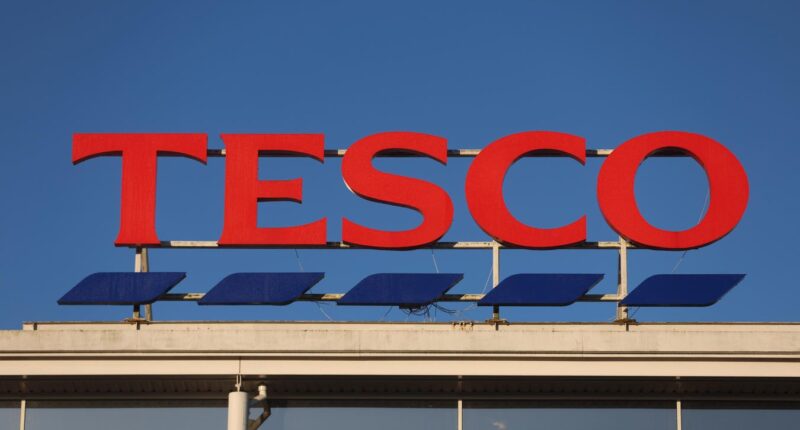Share this @internewscast.com
Following the release of its interim results, Tesco’s stock price experienced a brief surge, yet it seems to have reached its zenith. The shares have faced challenges in surpassing the 450p threshold, prompting me to maintain my stance that additional gains for the stock appear limited at this time.
Tesco’s interim results offered a positive surprise, particularly in terms of profitability rather than revenue growth. The group reported a 3.6% rise in revenue, totaling £36.04 billion, fueled by a 5.6% increase in UK and ROI sales to £24.67 billion and £1.54 billion, respectively. The Booker division achieved a modest 2.4% growth to £4.73 billion, while Central Europe posted a healthier 4.4% rise to £2.11 billion. Conversely, fuel sales declined by 9.8%, amounting to £2.99 billion.
The Proof was in the Pudding
The standout revelation was in the gross margin, which edged up by 6 basis points to 7.88%, despite the pressure of rising commodity costs. However, this was counterbalanced by increased labor expenses, including higher national insurance contributions and minimum wage hikes, leading to a 9 basis point decline in EBIT margin to 4.65%. Despite this, EBIT still improved by 1.5%, reaching £1.67 billion, attributed to robust sales performance and the company’s Save to Invest cost reduction initiative.
This translated into a 2.3% increase in pre-tax profits, reaching £1.41 billion. A slight reduction in net finance costs, down to £263 million from £269 million the previous year, contributed to this growth. With a tax rate of 26.9%, the attributable profit rose by 2.1%, totaling £1.03 billion. Significantly, Tesco’s earnings per share (EPS) saw a more pronounced jump of 6.8%, reaching 15.43p, aided by share buybacks.
Buoyed by these strong results, Tesco’s management revised its annual guidance upward, from an initial range of £2.7-3.0 billion to £2.9-3.1 billion. Although I anticipated a £100 million increase on the lower end, the £200 million boost there, along with an additional £100 million on the upper end, exceeded expectations. Given the unexpectedly robust margins in the first half, this guidance appears appropriate, albeit slightly conservative.
Marginal Gains in H2
During the earnings call, when probed about the reasoning for the guidance upgrade, the board indicated that their optimistic outlook hinges on the competitive landscape remaining stable, a sentiment I share. However, it is unlikely that Tesco will replicate the same gross margin gains in the second half due to less favorable weather, the impact of the EPR levy, and a persistently competitive pricing environment, especially as the Christmas season approaches.
When questioned on the earnings call on the rationale behind the guidance upgrade, the board mentioned that their outlook is still contingent on market competition not intensifying further – and I agree. That said, Tesco is unlikely to realise the same gross margin appreciation in H2 due to less favourable weather, the EPR levy, and a still intense pricing environment with Christmas expected to be as competitive, if not more.
In addition to that, I believe the continued UK market share gains of 0.8% which Tesco enjoyed towards the end of Q2 won’t be sustainable going into the winter. This would, therefore, limit the gross margin growth potential which Tesco benefitted from stronger economies of scale in H1. In fact, I’m forecasting market share gains to slow slightly, not helped by the tougher Y/Y comps the company is also lapping.
Pegged to Perfection
So, what’s next? Well, for FY26 through to FY28, I’ve dialled down my previous revenue forecasts by a tinge. One of the reasons for this is slower market share gains than previously expected moving forward, with ASDA’s decline bottoming out. Another is from a more modest growth outlook for ROI, as I anticipate competition across the Celtic Sea to remain hot for the foreseeable future despite the progress Tesco has made.
ASDA Sales Still in Decline Despite Rollbacks
Interpretiv
Nevertheless, this is largely offset by my bottom line upgrades in EPS. Because of the better margin mix Tesco is leaning towards (more discretionary items, online orders, Tesco Finest uplift), I have conviction that these will serve gross margins well. Combined with the impact of AI on efficiencies and the build out of Tesco’s digital proposition, I see plenty of opportunities for Tesco to build on its margins over the medium term.
As such, I expect the FTSE 100 stalwart to finish the year with an EBIT that’s slightly above the guidance the team has given, at £3.13 billion – exactly the same as last year. Interpretiv also has the group’s EPS CAGR at 11.2%, roughly unchanged from a previous 11.7%. However, with a PEG ratio of 1.4 against the blended sector and 5-year average of 1.6, I don’t see much upside for the Tesco share price. Thus, I reiterate my price target of 450p.







